
Monoceros is a faint constellation on the celestial equator. Its definition is attributed to the 17th-century Dutch cartographer Petrus Plancius. It is bordered by Orion to the west, Gemini to the north, Canis Major to the south, and Hydra to the east. Other bordering constellations include Canis Minor, Lepus, and Puppis.

The Rosette Nebula is an H II region located near one end of a giant molecular cloud in the Monoceros region of the Milky Way Galaxy. The open cluster NGC 2244 is closely associated with the nebulosity, the stars of the cluster having been formed from the nebula's matter.

The Trifid Nebula is an H II region in the north-west of Sagittarius in a star-forming region in the Milky Way's Scutum–Centaurus Arm. It was discovered by Charles Messier on June 5, 1764. Its name means 'three-lobe'. The object is an unusual combination of an open cluster of stars, an emission nebula, a reflection nebula, and a dark nebula. Viewed through a small telescope, the Trifid Nebula is a bright and peculiar object, and is thus a perennial favorite of amateur astronomers.

NGC 604 is an H II region inside the Triangulum Galaxy. It was discovered by William Herschel on September 11, 1784. It is among the largest H II regions in the Local Group of galaxies; at the galaxy's estimated distance of 2.7 million light-years, its longest diameter is roughly 1,520 light years (~460 parsecs), over 40 times the size of the visible portion of the Orion Nebula. It is over 6,300 times more luminous than the Orion Nebula, and if it were at the same distance it would outshine Venus. Its gas is ionized by a cluster of massive stars at its center with 200 stars of spectral type O and WR, a mass of 105 solar masses, and an age of 3.5 million years; however, unlike the Large Magellanic Cloud's Tarantula Nebula central cluster (R136), NGC 604's one is much less compact and more similar to a large stellar association.

The Eagle Nebula is a young open cluster of stars in the constellation Serpens, discovered by Jean-Philippe de Cheseaux in 1745–46. Both the "Eagle" and the "Star Queen" refer to visual impressions of the dark silhouette near the center of the nebula, an area made famous as the "Pillars of Creation" imaged by the Hubble Space Telescope. The nebula contains several active star-forming gas and dust regions, including the aforementioned Pillars of Creation. The Eagle Nebula lies in the Sagittarius Arm of the Milky Way.
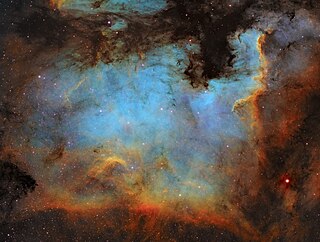
The North America Nebula is an emission nebula in the constellation Cygnus, close to Deneb. It is named because its shape resembles North America.

The Lagoon Nebula is a giant interstellar cloud in the constellation Sagittarius. It is classified as an emission nebula and has an H II region.
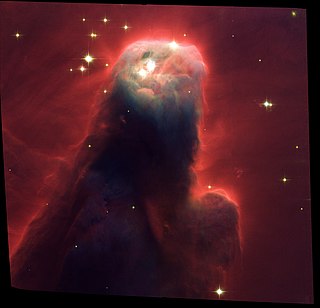
The Cone Nebula is an H II region in the constellation of Monoceros. It was discovered by William Herschel on December 26, 1785, at which time he designated it H V.27. The nebula is located about 830 parsecs or 2,700 light-years from Earth. The Cone Nebula forms part of the nebulosity surrounding the Christmas Tree Cluster. The designation of NGC 2264 in the New General Catalogue refers to both objects and not the nebula alone.

Sh2-279 is an HII region and bright nebulae that includes a reflection nebula located in the constellation Orion. It is the northernmost part of the asterism known as Orion's Sword, lying 0.6° north of the Orion Nebula. The reflection nebula embedded in Sh2-279 is popularly known as the Running Man Nebula.
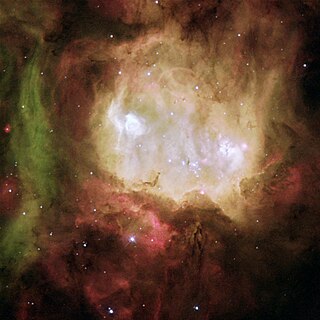
NGC 2080, also known as the Ghost Head Nebula, is a star-forming region and emission nebula to the south of the 30 Doradus (Tarantula) nebula, in the southern constellation Dorado. It belongs to the Large Magellanic Cloud, a satellite galaxy to the Milky Way, which is at a distance of 168,000 light years. NGC 2080 was discovered by John Frederick William Herschel in 1834. The Ghost Head Nebula has a diameter of 50 light-years and is named for the two distinct white patches it possesses, called the "eyes of the ghost". The western patch, called A1, has a bubble in the center which was created by the young, massive star it contains. The eastern patch, called A2, has several young stars in a newly formed cluster, but they are still obscured by their originating dust cloud. Because neither dust cloud has dissipated due to the stellar radiation, astronomers have deduced that both sets of stars formed within the past 10,000 years. These stars together have begun to create a bubble in the nebula with their outpourings of material, called stellar wind.

The Fox Fur Nebula is a nebula located in the constellation of Monoceros not far off the right arm of Orion and included in the NGC 2264 Region. In the Sharpless catalog it is number 273.
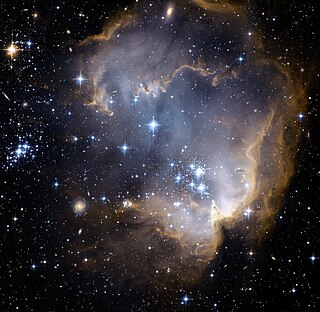
NGC 602 is a young, bright open cluster of stars located in the Small Magellanic Cloud (SMC), a satellite galaxy to the Milky Way. It is embedded in a nebula known as N90.

NGC 6357 is a diffuse nebula near NGC 6334 in the constellation Scorpius. The nebula contains many proto-stars shielded by dark discs of gas, and young stars wrapped in expanding "cocoons" or expanding gases surrounding these small stars. It is also known as the Lobster Nebula. This nebula was given the name War and Peace Nebula by the Midcourse Space Experiment scientists because of its appearance, which, in infrared images the bright, western part resembles a dove, while the eastern part looks like a skull. A petition by anime fans to rename it as the Madokami nebula, due to resemblance with a character, was unsuccessful.
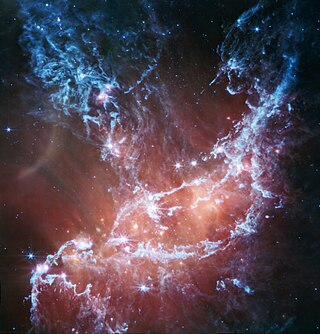
NGC 346 is a young open cluster of stars with associated nebula located in the Small Magellanic Cloud (SMC) that appears in the southern constellation of Tucana. It was discovered August 1, 1826 by Scottish astronomer James Dunlop. J. L. E. Dreyer described it as, "bright, large, very irregular figure, much brighter middle similar to double star, mottled but not resolved". On the outskirts of the cluster is the multiple star system HD 5980, one of the brightest stars in the SMC.
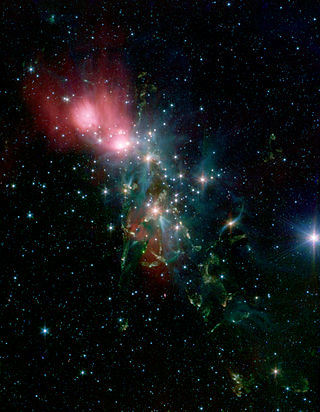
NGC 1333 is a reflection nebula located in the northern constellation Perseus, positioned next to the southern constellation border with Taurus and Aries. It was first discovered by German astronomer Eduard Schönfeld in 1855. The nebula is visible as a hazy patch in a small telescope, while a larger aperture will show a pair of dark nebulae designated Barnard 1 and Barnard 2. It is associated with a dark cloud L1450. Estimates of the distance to this nebula range from 980–1,140 ly (300–350 pc).

NGC 2244 is an open cluster in the Rosette Nebula, which is located in the constellation Monoceros. This cluster has several O-type stars, super hot stars that generate large amounts of radiation and stellar wind.

Sh2-155 is a diffuse nebula in the constellation Cepheus, within a larger nebula complex containing emission, reflection, and dark nebulosity. It is widely known as the Cave Nebula, though that name was applied earlier to Ced 201, a different nebula in Cepheus. Sh2-155 is an ionized H II region with ongoing star formation activity, at an estimated distance of 725 parsecs from Earth.

IC 5146 is a reflection/emission nebula and Caldwell object in the constellation Cygnus. The NGC description refers to IC 5146 as a cluster of 9.5 mag stars involved in a bright and dark nebula. The cluster is also known as Collinder 470. It shines at magnitude +10.0/+9.3/+7.2. Its celestial coordinates are RA 21h 53.5m, dec +47° 16′. It is located near the naked-eye star Pi Cygni, the open cluster NGC 7209 in Lacerta, and the bright open cluster M39. The cluster is about 4,000 ly away, and the central star that lights it formed about 100,000 years ago; the nebula is about 12 arcmins across, which is equivalent to a span of 15 light years.

RCW 49, also known as NGC 3247, is a H II region nebula located 13,700 light years away. Other designations for the RCW 49 region include NGC 3247 and G29 and it is commonly known as the Whirling Dervish Nebula. It is a dusty stellar nursery that contains more than 2,200 stars and is about 300-400 light years across. RCW 49 is recognized as among the brightest and most massive HII regions.




















